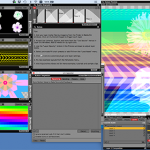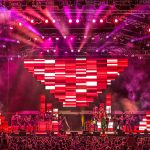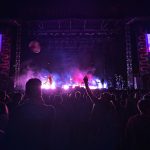
As media server software crosses over from being a technical solution to being a creative tool, the software will take a more central role.
Airplane rides make me write. I’m not sure what it is about the cramped quarters of the time machine/space tube, but I always feel the urge to pull out the old phone and write. (That’s right, I wrote this on my phone. Don’t judge.)
Anyway, I went to LDI in Las Vegas last fall and spent some time with the media server folks at d3 (I mean disguise) and Green Hippo. The more conversations I have with technicians, the more I research the super users of both media servers and screen blenders/presentation switchers, the more obvious it is that a lot of people are not so tuned-in on when to use a media server vs. a traditional presentation switcher.
Old Habits Die Hard
There is some old thinking out there that’s borne from years and years of using the Barco Encore System, then the E2 and Spyder solutions. Projection was the frontier of multiscreen, multisource video presentation, and those systems were a pretty nice solution for the task. When the resolutions got larger, the E2 and Spyder rose to the occasion. But we live in a much different world now. No one can argue that high resolution LED products have displaced a lot of projectors in the past few years. So why hasn’t the front end of the system caught up with the evolution in display technology? Old habits die hard.
I realize I’m speaking to a rather specialized audience here, but those of you who swear by your E2 and Spyder systems, consider this. What’s your playback source? Multiple Playback Pros? Maybe a media server (cough cough, isn’t that ironic?), or maybe a few presentation computers running Keynote or, God forbid PowerPoint? So, you’ve got all of these sources coming into your Spyder or E2, and your “looks” are programmed in advance, and your screen sizes and pixel maps are all preset for the show. For a projection setup, with multiple blends and large surfaces, this sort of configuration is going to work, just like it always has. But… did you know, in a disguise (d3) media server, you can program multiple pixel maps at massive resolutions? Not only can you change your “look” at a push of a button, you can also drop content into any number of spots (a timeline slot, a playback cue, a pip), on the fly. Did you know that blending multiple projectors is as easy as apple pie?
Multiple Control Surface Options
You can use a lighting desk via DMX, you can use a keyboard and mouse via an onscreen GUI or, what seems to be the most popular choice out there, you can use any tactile surface that runs the MIDI protocol. That gives you a lot of options. So, what’s so cool about that? There are countless manufacturers that make really, really cool, well-thought-out midi controllers, and they don’t cost $30K. At most, you might pay $1,000, and more often than not, you will pay only a few $100. That means the technician buys their own, the one that they spend time with, the one that allows them to work confidently and quickly.
Training is Still Essential
You still have to study and train on the media server itself. Don’t get me wrong, they are deep, complex, powerful tools that you don’t figure out on unboxing day, nor do you with your Spyder and E2 solutions. I think what I am getting at is, with a media server such as the disguise, Hippo or Watchout, you can build a much more robust playback, control and blending rig in a much smaller footprint. You guys can sort out that math yourselves. I’m not getting into a cost comparison here, but if you are, don’t forget to add up all of the components currently required to run your system. Don’t forget to look at the pixel output capability of a media server vs. the blender, external playback solution. I know some of you uber-cool Spyder dudes are fond of stacking machines just to get enough output firepower to light up all of the pixels on your show.
My Take on This Debate
Although it’s safest to say “the jury is still out” when pressed for a verdict on the Media Servers vs. Presentation Switchers debate (for the perspective of Tim Riley from Green Hippo, Troy Fujimura from disguise and Erik Iverson from Barco, see sidebar, this page), I think it’s also obvious that both sides of this topic would benefit from an open discussion, with some real time fact checkers. There seems to be a lot of “fake news” going around. I am going to try and facilitate this conversation via live video. Trying to do it via email and phone calls has been similar to walking from one booth to another and listening to manufacturers say things about one another’s box, when just heard the complete opposite “fact” from the manufacturer being spoken about. I can tell you this for sure — Barco and Christie seem to have a narrow and somewhat uninformed view on today’s media server capabilities. I’m not saying the E2 or Spyder route is obsolete by any stretch. Those manufacturers would hunt me down and kill me for coming out and saying something like that. I’m just encouraging anyone who is reading this to consider some new approaches to some old situations. It’s this customers belief that the Barco E2 or (E whatever they update it with) and the Spyder way of doing things, their days are numbered. One area where the switcher companies seem to be leading the charge vs. the media server companies is access to training. Nothing is going to make a show run smoother than having a properly trained technician who is confident and comfortable in the system configuration they are using. Its time to get out of your comfort zone and look forward, the media server has come of age, and I am here to serve you notice that the other way is, uh… over, like fax is over. Yeah, fax still works, and in some ways that old battle-ax is more secure than our magic inter-web, but are you really gonna go out and invest in a brand new fax machine? No. If you’ve got one, and you like it, and it works, great, run that box into the ground, but if you’re in the market for a new way of moving a document from your office to someone else across town, by golly, I would NAWT (insert thick Boston accent) be looking at the latest and greatest fax machine, and neither should you. Peace!
[Mic drop.]
Media Servers vs. Screen Blenders: The Debate Continues
Before giving Erik Iverson from Barco the last word, author Doug Murray reached out to Tim Riley from Green Hippo and Troy Fujimura from disguise with the following question:
Q: Are there any specific tasks that a media server is just better at performing than E2 units and Spyders, yet we never see anyone using that way?
Tim Riley/Green Hippo: Yes, large format media storage and playback across multiple displays of differing types. Productions are still playing out 4K backgrounds from a laptop, into an E2/Spyder , then out to the destinations. Then there is another machine for the videos and another machine for the Keynote. All requiring redundancy.
Troy Fujimura/disguise: Yes, placing and moving input windows in 3d space and over dimensional objects. Switchers are good at placing windows in 2D spaces, but because they lack the interface to understand the 3D world, it is impossible for them to work with dimensional mapped surfaces. Presentation screens are commonly built as large TV screens, this can now be changed to deliver this information onto other odd size and organic shapes. Another aspect of production that works very well on media servers is choreographing complex switching to time. Switching on beat or with timecode can be very repetitive and hard to rehearse. Being able to visualize this and sequence to time is a unique feature of media server software. This can make media server software, such as disguise, an extremely powerful system control tool.
Tim Riley: Since the advent of DP and 4K outputs, about four years ago, servers have been multiples of DVi or dual link DVi, which might be split out to 2 x 1080 @ 30fps. The capability to route multiple signals to multiple destinations has not yet been entirely grasped by the world of production — many and most are still working with multiple (main and back up) playback machines for stills and video, plus PowerPoint machines for clients to amend and change up until the last minute. These then all route though a Spyder or an E2 router to projection, LED screens and Multiview and comfort monitors.
This is no longer the case when a media server of note is specified. All video media and still images are stored on the server; PowerPoint and cameras can still be captured and routed (with minimal 3 frame delay) out to the same designated displays.
The most probable reason for this is ignorance. The logical upgrade route from the old Encore system is up to the E2. This new Encore will hold stills and, of course, route 1080 and 4K signals as required. However, the multiple playback devices are still required, and there has been no saving in operator manpower. When using a media server, there is one operator for all playback and routing plus a keynote operator. A saving of at least 1 person plus the playback devices. As for cost, a 4 x 4K media server plus backup will cost less than a pair of E2 or Spyder routers.
Further benefits from a media server are the ability to route large format (pixel) canvases to multiple destinations in perfect sync, add effects such as Notch, operate via third party devices such as lighting desks, choose the quality of media to ingest and playback and run backup machines in tandem with main for fail over. How many E2 or Spyder systems run full redundancy?
Troy Fujimura, disguise: Show systems will continue to become more complex. There will be a constant demand for environments that include greater numbers of pixels. The only way to create in these large pixel count environments will be with a software solution like the disguise software. As media server software crosses over from being a technical solution to being a creative tool, the software will take a more central role. Switchers, routers and outside inputs will continue to evolve.
Doug Murray also noted that the switcher folks are not going down without a fight. Here’s the perspective he got from Erik Iversen, Barco ImageProcessing product manager:
Erik Iverson, Barco: For the typical staging event, I don’t see the screen management system going away. In your typical media server system, you must pre-program every look and effect, not to mention they have a very limited number of live input options, nor do they support look-ahead preview. An E2 is even capable of accepting new inputs during the show. This is made possible with the multi-viewer and preview bus, which allows the operator to confirm the source looks correct before it goes to screen. The ability to preview sources is essential in live production of any form.
The E2 is still better at mapping large LED and blended projection displays than media servers. In LED especially, where you tend to have very non-standard resolutions, the E2 is able to create custom output resolutions and map the pixels between the “cracks” of typical SMPTE or VESA resolutions. These large displays will go way beyond what a single sever system can handle, so the E2 helps by combining several media servers into a single continuous canvas, and then can create the “slice and dice” of the content where it is needed for the LED wall mapping. When all of the content is pre-produced, the media server systems perform quite well. But, as soon as you add live cameras and demo computers into the mix the operator really needs the ability to preview the next look before it goes to screen. Screen management systems allow the operator to have much better situational awareness than a typical media server system, as a system like the E2 is designed to manage multiple live inputs and to manage them live.
Doug Murray is president of Upstage Video in Lititz, PA. For more information, go to www.upstagevideo.com.


